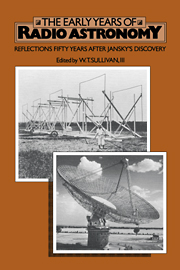Book contents
- Frontmatter
- Contents
- Preface
- THE EARLIEST YEARS
- AUSTRALIA
- ENGLAND
- THE REST OF THE WORLD
- BROADER REFLECTIONS
- Styles of research in three radio astronomy groups
- The influence of radio astronomy on cosmology
- Nanohertz astronomy
- Radio astronomy and the nature of science
- Biographical notes on contributors
- Name index
- Subject index
Nanohertz astronomy
Published online by Cambridge University Press: 05 March 2010
- Frontmatter
- Contents
- Preface
- THE EARLIEST YEARS
- AUSTRALIA
- ENGLAND
- THE REST OF THE WORLD
- BROADER REFLECTIONS
- Styles of research in three radio astronomy groups
- The influence of radio astronomy on cosmology
- Nanohertz astronomy
- Radio astronomy and the nature of science
- Biographical notes on contributors
- Name index
- Subject index
Summary
Aim
This paper is an attempt at what with a sophistication understandable to radio astronomers might be termed nanohevtz astronomy: the art of registering the coming and going of astronomical convictions in periods of the order of 109 seconds = 30 years. This approach is complementary to the common one, where the history of science is described by focusing on the sudden discoveries and the rapid breakthroughs of insight. This complement is as necessary as are the added measurements at very short spacings in the Fourier synthesis of extended sources. Otherwise a broad underlying valley or elevation might be misjudged and the basic structure misinterpreted. And – to continue this metaphor – the historical development of science is indeed such an extended source with a highly complex structure.
How can we ‘measure’ these low-frequency components? The history of science that can be reconstructed from published papers is far from complete. A substantial part of the development of scientific knowledge is not documented this way. The relative importance of this ‘hidden’ part varies with the field: it is probably smallest in the gathering of new data, moderate in the development of new techniques and largest in the growth of theoretical insight and interpretation. In this ‘hidden’ part the ideas originate, grow (rightly or wrongly) into an accepted theory, or (again rightly or wrongly) are discarded. The scene is: sleepless nights, the private work room, the class room, visits, phone calls, bull sessions, workshops, team meetings, some correspondence, the hall where a symposium is being held, or the coffee shop across the road.
- Type
- Chapter
- Information
- The Early Years of Radio AstronomyReflections Fifty Years after Jansky's Discovery, pp. 385 - 398Publisher: Cambridge University PressPrint publication year: 1984
- 3
- Cited by



